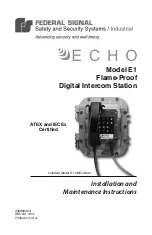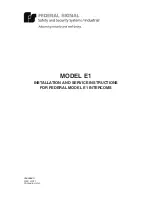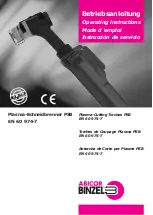
TL880D
Very-Low-Frequency
Speaker System
• Designed for cinema subwoofer use
• High acoustic output to below 20 Hz
• Two EVX-180A woofers provide very
high peak and long-term output that
complements the dynamic potential of
digital sound on film
• 2,000 watts continuous program
• Side-mounted connection panel
facilitates hookup when depth behind
the screen is restricted
• High output ability in the 20- to
40-Hz range is also ideal for
very-low-frequency synthesized
effects, down-tuned bass guitars
or pipe organ
• Approved for subwoofer use in THX
®
cinema systems*
Description and Applications
The Electro-Voice TL880D is a member of
the TL series of low-frequency enclosures.
The TL880D is a dual direct-radiating vented
design that provides high efficiency, low
distortion and excellent low-frequency
performance. The TL880D employs two
long-throw EVX-180A 18-inch loudspeak-
ers, in an 15.5-ft
3
, black-finished enclosure
without grille. It is specifically designed to
meet the low-frequency demands of digital
cinema sound, in subwoofer applications.
The TL880D’s high pumping capability, high
acoustic output ability and extended bass
response (to below 20 Hz) make it par-
ticularly appropriate for the dynamic po-
tential of the digital cinema application. (The
TL880D is approved for subwoofer use in
THX
®
cinema systems.)* The side-mounted
input panel facilitates behind-the-screen in-
stallation, where limited space between the
screen and theatre wall often makes it diffi-
cult to connect to the back of an enclosure.
The TL880D’s performance characteristics
also make it highly appropriate as the
subwoofer in large, multiway systems for
contemporary music playback and sound
reinforcement. The TL880D has more out-
put below 40 Hz than the devices typically
used in these applications.
Frequency Response
The TL880D’s axial frequency response was
measured in Electro-Voice’s large anechoic
chamber at a distance of 10 feet with a swept
sine-wave input of 4 volts. Figure 1 has been
averaged and corrected for 1 watt/1 meter.
Directivity
The directional characteristics of the
TL880D were measured in Electro-Voice’s
large anechoic chamber; the test signal was
one-third-octave filtered pink noise at the
frequencies indicated. A full spherical
measurement system was used, which is
compatible with the AcoustaCADD
TM
com-
puter-aided design program. All directional
information was measured at 20 feet.
Figure 2 illustrates the horizontal and
vertical polar responses. Figure 3 shows the
horizontal and vertical beamwidths.
Beamwidth is the angle at which the hori-
zontal and vertical polar responses have
decreased in level by 6 dB when compared
to the axial frequency response.
Figure 4 illustrates the total directivity of the
TL880D. The directivity factor R
θ
(Q) is the
relative value, at a point, of the TL880D
when compared to an ideal spherical
response. The directivity index, D
i
, is calcu-
lated by D
i
= 10 log R
θ
.
Power Hanndling Capacity
To our knowledge Electro-Voice was the first
U.S. manufacturer to develop and publish a
power test closely related to real-life condi-
tions. A random noise input signal is used
because it contains many frequencies simul-
taneously, just like real voice or instrument
program. The signal contains more energy
at extremely high and low frequencies than
typical actual program, adding an extra mar-
gin of reliability. The test combines not only
the overall long-term average or continuous
level—which our ear interprets as loud-
ness—but also short-duration peaks which
are many times higher than the average, just
like actual program. The long-term average
level stresses the speaker thermally (heat).
The instantaneous peaks test mechanical re-
liability (cone excursion). Note that the sine-
wave test signals sometimes used have a
much less demanding peak value relative to
their average level. In actual use, long-term
average levels exist from several seconds on
up. We test for several hours, adding an-
other extra level of reliability.
_________________
*THX is a registered trademark of Lucasfilm Ltd.
























